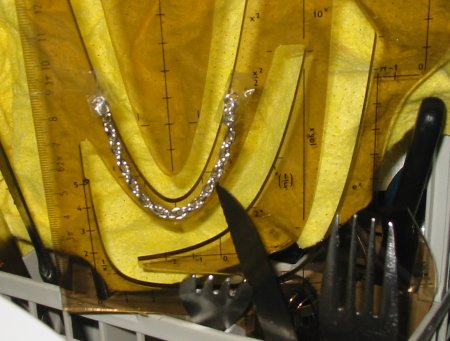chain and parabel

I attached a little silvery chain to a mathematical curve template in order to illustrate the difference between a catenary and a parabola.
Then I put the curve template (also called french curve, also on google images) into the dishwasher in order to get it upright for an orderly scientific photo. The forks and knives in the image are disturbing, but well one has to live with them for now.
The experiment displays a line which is described by a hanging chain.
If one compares it with the line of a parabola given by the function f(x)=x^2 (on the curve template) then one sees that the two lines are only almost fitting and in fact a better mathematical model for a hanging chain is the catenary, given by the cosh function f(x)=cosh(x), i.e. the hyperbolic cosine (not to be confused with a hyperbola). The model is constructed via the physical picture of many chain links taking each other by the hand which are subject to a constant gravitational force, or in other words: if you cut the chain at various points then the repective chunks would fall down separately.
There are very beautiful partially interactive links on the Wikipedia catenary site, which illustrate this.
The above observation is already described in this old mathematical physics paper from the early 17th century, which is beautifully accessible thanks to the work of people who had fun with mathematics. There is also a tender drawing of down parabolas.
-> about parabolic flight
March 28th, 2021 at 9:16 am
If one listens to this song of the Threepenny opera then one can only be happy that – in contrast to the end twenties- there are now enough home appliances in Berlin.
March 30th, 2021 at 11:54 pm
In Wikipedia it is written:
“adapted from” unfortunately doesn’t reflect the fact that Berthold Brecht often downrightly distorted the meanings of the original texts.
Even R. Hubert found that:
As another example you can have a look at Villon’s poem Ballade des dames du temps jadis (nicely interpreted by Georges Brassens) and Brecht’s Nanna’s Lied (translation here on p.25)(interpretation for example by Ute Lemper). Nanna’s Lied is supposed to be an adaption of the Ballade des dames du temps jadis – however apart from maybe the sentence “Where are the snows of yesteryear?” it has a completely different content.
April 25th, 2021 at 9:39 am
@Interbrätfun
Cat also likes the Ute Lemper version and liked your comment so she didn’t keep silent but decided to present her own “distortion” of Nanna’s Lied. It is an “Hommage to struggling scientists.”
From the soundcloud text: